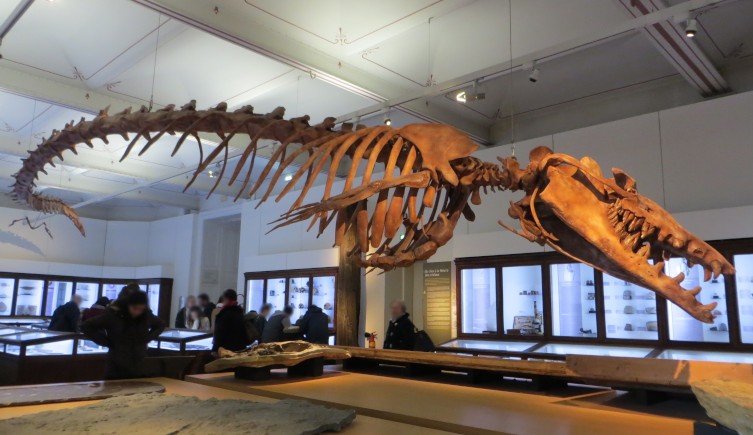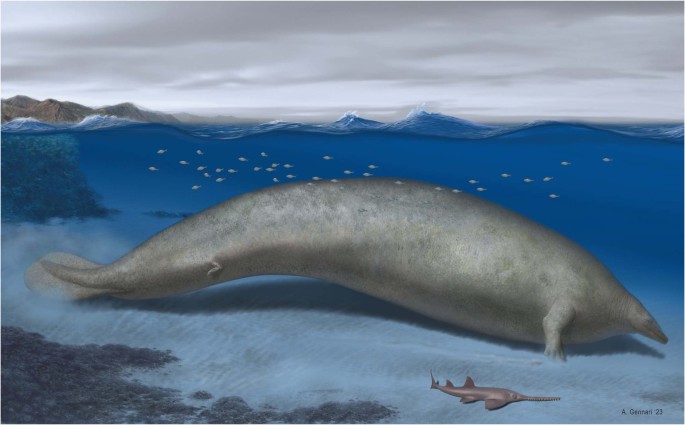In a recent discovery, scientists have unveiled a new species of early whale that could potentially hold the title as the heaviest animal to have ever lived. Found in Peru, the fossils of this ancient cetacean, named Perucetus colossus, are rewriting the history of whale evolution.
While the exact weight of this remarkable creature remains a subject of debate, its unique skeletal structure suggests that this was certainly an extraordinary creature. Researchers speculate that Perucetus colossus (which belongs to a group of extinct cetaceans known as basilosaurids that had eel-like bodies) could have reached an astonishing weight of up to 340 tonnes, potentially making it twice as heavy as the the blue whale, currently the largest animal that ever lived on earth.
According to the scientists, “The estimated skeletal mass of P. colossus exceeds that of any known mammal or aquatic vertebrate.”
Though uncertainties persist about the precise weight of this 40-million-year-old whale, the unparalleled nature of its fossils hints at a creature unlike any known species today. This discovery opens up new avenues of exploration and sheds light on the fascinating evolutionary journey of whales.
Dr Travis Park, who researches whale evolution at the Natural History Museum (NHM) and was not involved in the study, told the NHM, “Perucetus is the size of a whale but would have had a way of life more like a manatee or dugong.”
“While it may not have been as heavy as 340 tonnes, it pushes back the occurrence of extreme body mass in the cetaceans by about 30 million years. It demonstrates just how important Peru is to study ancient marine fossils, and that the cetaceans have many more surprises left in store.”
A total of 18 bones were unearthed during the excavation, comprising 13 vertebrae, four ribs, and a section of the right hip. What sets these discoveries apart is their significant size, notably surpassing the dimensions of bones belonging to other whales from the same ancient era.

Two vertebrae (a–l) and three posterior ribs (m; R-b,c,d) of Perucetus colossus (MUSM 3248, holotype). Bianucci et al 2023 Nature
The researchers calculated the weight of the skeleton by using the size and density of the bones. They also compared the whole skeleton to Natural History Museum specimens such as Hope the blue whale. This led them to estimate that just the skeleton of the Perucetus weighed in at between 5.3 to 7.6 tonnes, making it the heaviest of any mammal and approximately the same as a fully grown African elephant. They then used a value known as skeletal fraction or SF to measure the total weight of this gigantic creature. SF represents the amount of overall body mass made up of bones, so if the size and weight of a skeleton is known the SF can be used to deduce the total body weight of the specimen. This technique helped the researchers to estimate that Perucetus’ weight likely lay somewhere between 85 and 340 tonnes.
The eventuality that it did weigh 340 tonnes would make it the largest animal that ever lived on earth.
But no matter what the weight, this find is still changing the knowledge we have of whale evolution.
“In the overall history of cetacean body size, Perucetus is definitely an outlier,’ Travis told NHM. ‘We knew that one of its relatives, Basilosaurus, was reaching around 20 metres in length but it was nowhere near as heavy.”
“Other whales didn’t reach a similar weight until the evolution of baleen whales tens of millions of years later. Even if it’s not heavier than a blue whale, it is probably pretty close to the threshold of how big these animals can be.”

Basilosaurus an unsual cetacean which had an eel like body. Image: Asmoth CC BY SA 40 Wikemedia
The findings of the study were published in the journal Nature.







